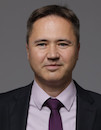Mobile Communications
Data is displayed for academic year: 2023./2024.
Exercises
Laboratory exercises
Course Description
Basic characteristics of wireless systems are described, with an emphasis on mobile systems. The phenomena in the wireless channel and methods of suppressing the influence of the channel on the reliability of communication are studied. A cellular planning overview and the basics of MIMO technology are given. The most important mobile systems are presented, with a more detailed look on features of 5G network.
Study Programmes
University undergraduate
[FER2-HR] Wireless Technologies - module
(6. semester)
University graduate
[FER3-HR] Audio Technologies and Electroacoustics - profile
Elective Courses
(2. semester)
Elective Courses of the Profile
(2. semester)
[FER3-HR] Communication and Space Technologies - profile
(2. semester)
[FER3-HR] Computational Modelling in Engineering - profile
Elective Courses
(2. semester)
[FER3-HR] Computer Engineering - profile
Elective Courses
(2. semester)
[FER3-HR] Computer Science - profile
Elective Courses
(2. semester)
[FER3-HR] Control Systems and Robotics - profile
Elective Courses
(2. semester)
[FER3-HR] Data Science - profile
Elective Courses
(2. semester)
[FER3-HR] Electrical Power Engineering - profile
Elective Courses
(2. semester)
[FER3-HR] Electric Machines, Drives and Automation - profile
Elective Courses
(2. semester)
[FER3-HR] Electronic and Computer Engineering - profile
Elective Courses
(2. semester)
[FER3-HR] Electronics - profile
Elective Courses
(2. semester)
[FER3-HR] Information and Communication Engineering - profile
Elective Courses
(2. semester)
Elective Courses of the Profile
(2. semester)
[FER3-HR] Network Science - profile
Elective Courses
(2. semester)
Elective Courses of the Profile
(2. semester)
[FER3-HR] Software Engineering and Information Systems - profile
Elective Course of the profile
(2. semester)
Elective Courses
(2. semester)
Learning Outcomes
- Explain the basic features of a wireless channel and equalization techniques.
- Explain the main characteristics of mobile systems from different generations.
- Evaluate correctness of cellular planning.
- Explain the basics of MIMO technology.
- Recognize the main features of 4G network.
- Recognize the main features of 5G network.
Forms of Teaching
Lectures
Lectures are conducted with the help of power-point presentations with explanations on the board. Lectures are available online in electronic form.
ExercisesSolving numerical examples.
Independent assignmentsDuring the semester, projects from the course area are planned. More complex tasks would be solved, most often with the use of software tools. Each project would be handled by smaller group of students.
LaboratoryLaboratory exercises are planned during the course. At the end of each exercise, the activity and understanding would be check.
Grading Method
| Continuous Assessment | Exam | |||||
|---|---|---|---|---|---|---|
| Type | Threshold | Percent of Grade | Threshold | Percent of Grade | ||
| Laboratory Exercises | 0 % | 10 % | 0 % | 10 % | ||
| Homeworks | 0 % | 5 % | 0 % | 5 % | ||
| Mid Term Exam: Written | 0 % | 30 % | 0 % | |||
| Final Exam: Written | 0 % | 35 % | ||||
| Final Exam: Oral | 20 % | |||||
| Exam: Written | 0 % | 65 % | ||||
| Exam: Oral | 20 % | |||||
Week by Week Schedule
- General information about communications, wireless communications, basic concepts - two-way transmission, multiple access, frequency, power. Historical development of wireless communications, services and generations of mobile systems.
- Antenna systems, electromagnetic wave attenuation in free space, receiver sensitivity, link budget.
- Mechanisms of EM wave propagation, reflection and transmission, scattering, diffraction, two-ray model, introduction to fading, Doppler effect, multipath propagation.
- Channel filter model, deterministic channel functions, channel impulse response, coherence bandwidth, Doppler dispersion, coherence time. Special cases of wireless channel. Narrowband and broadband systems.
- Fading. Diversity.
- The bit error rate in the communication channel. Wireless channel models.
- Equalization techniques.
- Midterm exam
- Cellular system basics. Capacity in cellular network, Handover.
- Fourth generation mobile systems (4G)
- MIMO System model; System capacity. MIMO - Example of realisation in LTE system
- Architectures of 4G/5G mobile networks, Protocol architectures of radio acess network (RAN) and core network in 4G/5G systems
- Quality of Service (QoS) in 4G/5G networks, Network Function Virtualization in 5G networks
- The concept of network slicing, Technologies of wireless interface in 5G networks
- Final exam
Literature
(.), E. Zentner: Antene i radiosustavi, Graphis 2001.,
(.), Svaka literatura koja u naslovu ima ključne riječi: Wireless Communications,
Andrea Goldsmith, (2005.), Wireless Communications, Cambridge University Press
For students
General
ID 222449
Summer semester
5 ECTS
L1 English Level
L1 e-Learning
45 Lectures
0 Seminar
15 Exercises
12 Laboratory exercises
0 Project laboratory
0 Physical education excercises
Grading System
91 Excellent
77 Very Good
63 Good
50 Sufficient


 Pristupačnost
Pristupačnost

